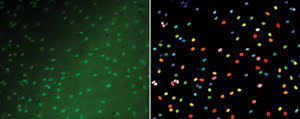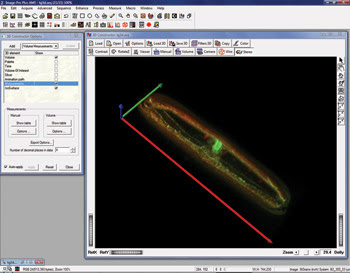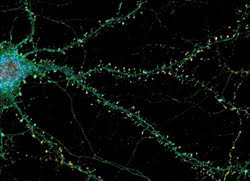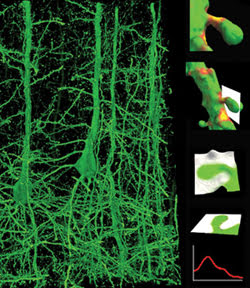Even in these economic times, you may find a picture that’s worth a thousand words, but you can guarantee its value by using the best analytical tools available. Thanks to advances in algorithms and computer hardware, software now can tease more information out of an image, saving clinicians time and improving patient outcomes. It also can make researchers more productive by enabling them to sift through more data. A survey reveals where image analysis stands today and illustrates where it might be headed.
Christian Kier is marketing manager for MetaMorph, an image capture and analysis package from MDS Analytical Technologies of Sunnyvale, Calif. He explained that ease-of-use improvements are a focus for the company, rather than such innovations as a new algorithm to segment data into areas of interest.

A feature in the MetaMorph image capture and analysis package offers adaptive background correction. On the left is the data as acquired, while on the right is the data after adaptive background correction, making it easier to count the nuclei present. Courtesy of MDS Analytical Technologies.
“We have to enable a technician in a laboratory to find the proper tool to use to solve the problem at hand without turning it into an engineering exercise,” Kier said.
The company is doing this through the use of such things as wizards that guide users. Kier said successful simplificationinvolves careful interface design as well as research into how customers use the software.
Hardware changes also drive software changes. These modifications include support for new cameras and for the advent of multicore processors that promise to make image analysis faster because some tasks are well suited to parallel processing on multiple cores. This, in turn, results from the fact that the same function often is performed repeatedly on a subset of the data, such as a single pixel or a set of pixels. The company has software that parallelizes image analysis as well as database products for image storage and retrieval of large data sets.

Three-dimensional image-rendering capabilities, such as these shown in Image-Pro Plus, make it easier to visualize complex microscopy image captures. Courtesy of Media Cybernetics Inc.
Media Cybernetics Inc. of Bethesda, Md., also is addressing problems associated with large data sets. Although a particular concern for high-content analysis, the issue also can show up in research settings because of the need to collect many images very quickly. The latest version of the company’s flagship product, Image-Pro Plus, includes just-in-time image loading. This feature exploits memory management capability to avoid loading an entire image database into memory before it can be viewed.
“This only displays what you need to be viewing at the moment,” said Kathy Hrach, the company’s software product manager. “All that data is there. It just loads faster.”
Both of these software packages are sold by BioVision Technologies Inc. of Exton, Pa., a systems integrator of microscopy imaging solutions for the life sciences. The company also sells its own software, which, unlike the other packages, runs on a Mac.

This multifluorescent image of dendritic spines was captured with a 60× oil objective and iVision-Mac software. Courtesy of BioVision Technologies.
BioVision President Ken Anderson said that the software, iVision-Mac, is aimed at researchers. It does multicolor capture, time lapse and 3-D capture with rendering but not 3-D analysis. It is intended to control imaging systems for data capture and to complete 2-D analysis.
When it comes to software or systems, Anderson noted that researchers often must do a measurement repeatedly, with parameters set so that one run will be the same as the next. The most elaborate analysis in the world may not make up for data collection problems, he said. For that reason, the company’s software includes a simple scripting approach to better provide reproducible data. It also is why a simple approach can actually be better.
“The more flexibility and the more elaborate your system is, the more you have to know,” Anderson said.
Openings in open source
Of course, not all image analysis software is commercial. Quite a few packages have been developed by researchers and are freely available. One of the most famous is ImageJ, a public domain Java-based image processing program with limited 3-D capabilities developed by Wayne Rasband of the National Institutes of Health in Bethesda.
Much less well known but gaining in popularity is ImageSurfer, a free 3-D imaging software package for visualization and analysis. Alain C. Burette, an assistant biology professor at the University of North Carolina at Chapel Hill, heads the program’s development.

The distribution of a plasma membrane calcium pump in the dendritic spines of pyramidal neurons is visualized by the open source software package ImageSurfer. Courtesy of Alain C. Burette, University of North Carolina at Chapel Hill.
He said that it originally was designed to answer a question: Where are the calcium pumps located in neurons? However, ImageSurfer has been put to use in a variety of other situations, including the study of the Golgi apparatus of cortical pyramidal neurons, the distribution of ions in thyroid tumor cells, myosin-based molecular motors and even nanofabricated devices.
This multiplicity of applications arises because many researchers have similar technical requirements. ImageSurfer uses algorithms to render surfaces that have the same calcium concentration with the same color. This colored isosurface capability can be used to answer such questions as: What is the membrane distribution of a given protein or molecule?
“Thus, while this tool is limited in scope, it applies to a large number of biological questions and can be useful for a number of labs,” Burette said.
Plans call for a 64-bit version of ImageSurfer, which is important because 64-bit software can address a far larger memory space – and therefore more data – than can be done by current 32-bit applications. For instance, a 64-bit Windows application running on a 64-bit operating system has a 16-TB virtual memory limit, more than 4,000 times the 4-GB limit for a 32-bit application.
Other planned improvements include a plug-in structure to make the software modular and evolvable. Besides usability enhancements, there also are efforts under way to provide new tools for image restoration and analysis. The development of new capabilities will take about a year and will depend upon funding, Burette said.
He added that the fact that ImageSurfer’s development is being headed up by a biologist is a plus, as is the focus on meeting specific research needs. The result should be a viable and useful tool in a real working environment, he noted.
For open-source projects that are being revised by someone other than the original developer, there is a crucial need: documentation. Recording what was done and why can be a particular problem for busy researchers, said Belinda Seto, deputy director of the National Institute of Biomedical Imaging and Bioengineering in Bethesda. The institute helps fund a wide range of medical technology development, some of which involves the development of image analysis, and visualization algorithms and software.
Knowing of the problem presented by having to detail what was done in developing a particular program, the institute is taking steps to attack that issue, Seto said. “We give a small grant to allow investigators to clearly document the code.”